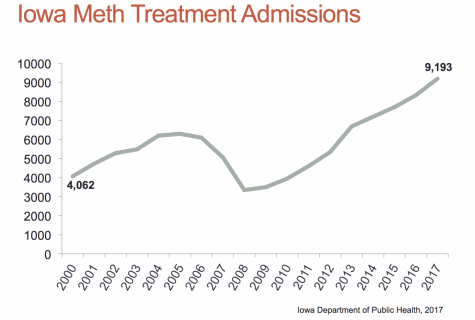December 11, 2018
“You can’t cure your own addiction,” Komendowski said. “Nobody is really defined as an addict until they’re busted for it.”
But for meth users, treatment options are not as accessible.
According to the Iowa Public Health Department, from 2011 to 2017, methamphetamine-related deaths increased from 12 to 96, an eight-fold increase. From 2016 to 2017 alone, deaths increased by more than 23 percent.
Anthony Miller, a UI clinical professor of psychology, said that with opioids, medication-assisted treatment can be implemented, as methadone and Suboxone can be used to regulate cravings and withdrawals. Currently, such treatment is not offered for methamphetamine users.
“Lots of things have been tried, and nothing that’s available makes a difference in terms of addiction,” Miller said. “The treatments are more psychotherapeutic, and we could probably do more to develop that.”
Data from the Iowa Public Health Department show that more Iowans were admitted to hospitals for methamphetamine treatment than ever before. While treatment for cocaine users has declined steadily since 2012, nearly 10,000 Iowans were treated for meth use last year.

According to these data, that makes Iowa the national leader for meth treatment. Data from the Public Health Department, released in June, showed that Johnson County had the second-lowest rate of admissions for methamphetamine treatment with 28.5 per 100,000 people. In comparison, Wapello County saw 613.4 per 100,000 people.
“By its nature, addiction is not as visible as fires and explosions,” Woolery said. “A lot of people who suffer from addiction are not inclined to publicly talk about it, but we know that there’s a pretty significant demand and use of meth in Iowa.”
Komendowski said addiction needs to be treated from a holistic view; methamphetamine addiction does not come from any one given source, and addiction will never be curbed unless demand is stopped.
“Addiction is a disease, and we have to protect people from that,” Komendowski said. “But if we don’t look at the mental health and underlying disparities that may drive people to the point of looking for drugs, then they will find some drug. Whichever one is the easiest to find, they’ll do. Humans are creatures of habit, and dopamine is a very powerful way to get people to do that.”
If we cannot protect youth from the dangers of drugs, he said, it is necessary to teach the risks to shift their attitude toward substance abuse.
“Iowa is No. 1, or somewhere near No. 1, in corn, beans, cattle, hogs,” Komendowski said. “When farmers spot invasive weeds, they put every resource they have to keep that crop free of them. And yet, when invasive things like methamphetamine or illegal opioids affect our culture, we don’t show the same passion. We don’t think of children as important a crop as corn.”